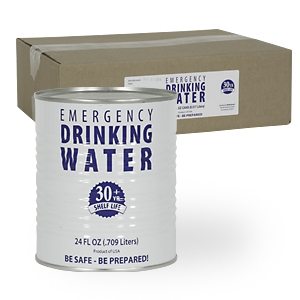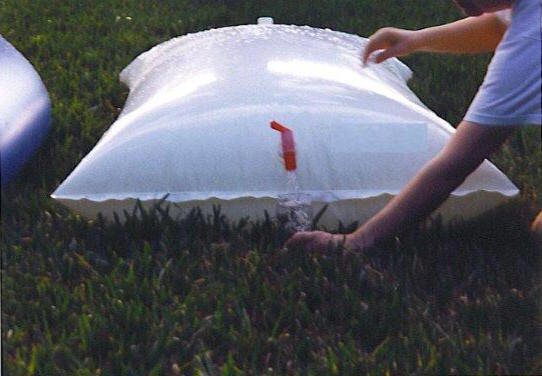Water is more important than food as you can be dehydrated before starving to death. In 3 days you’ll need water whereas in 3 weeks you’ll need food. (You’ll need medical care if you went 3 weeks without food.) See the Rule of 3.
The problem with water is it can’t be compressed into a small space or dehydrated into a smaller package. It takes up space no matter what form or container you use to store it in. Stored water can last up to 6 months as long as it’s not exposed to extreme temperature changes like in a garage. If you have a basement, that is an ideal location to store large quantities of water. But, then there’s the weight aspect. Water is heavy no matter what form or container it may be in. Water is one of the most valuable resources you can stockpile for a disaster but also one of the most difficult to store.
The amount of water needed to keep a family or individual alive is almost insane when you think about the very general 1 gallon per person per day method. That’s a lot of bottled water if you do the calculations and a major storage requirement. A family of four will need 55 gallons to last them for 2 weeks time based on the formula of 1 gallon per person per day. Storing mass quantities requires some forward thinking and planning. (Keep in mind that this 1 gallon per person is for personal hygiene, cleaning and drinking per day.)
Cost and space come into play as it does with canned food. Sure, you could go out and buy a couple of 55 gallon barrels for potable water but if you live in a small house or an apartment, where do you store it?
One cost effective option is to use empty 2 liter soda bottles. This idea has been around for some time and it works very well. Thoroughly wash and rinse (clean and sanitize) the old bottles when you finish the last of your favorite beverage and make sure there is no residue left inside. Once dry, peel off as much of the exterior label as possible and fill with water adding regular household bleach according to the chart below. Non-scented bleach, remember to only use NON-SCENTED. I find that Clorox works really well and is relatively inexpensive while being multifunctional. Tape an eye dropper to the bleach bottle along with a copy of this chart so it’s handy.
Diagrams/Charts
| Amount of Water | Amount of Bleach |
| 1 Quart | 2 Drops |
| 1 Gallon | 8 Drops |
| 5 gallons | 1/2 Teaspoon |
Now that you have a collection of 2 liter bottles, filled and date labeled with water how do you keep them organized? One method is to block and brace the bottles with cases of canned food. The other method is a bit more intuitive. While you’re out and about driving around town, look at the rear of grocery and convenience stores. You will see plastic racks that distributors deliver 2 liter bottles to the store. These racks, in some cases are left behind and eventually thrown out. In other cases, they are left for the soda representative to collect and bring back. The prudent course of action would be to talk to the store manager about these racks and see if you could obtain a few for your own use. These racks will hold 8 bottles and can be stacked as high as you’re comfortable with. If you can find 3 liter bottles and their racks, those work as well.
Milk jugs, the opaque type, are not something to store water in due to their chemical content. It’s recommended to use only food grade containers or PETE containers when storing water.
As with any stored water, you need to rotate it every 6 months pouring out or saving the old water in a clearly labeled non-potable water container. I know there are ways to purify stored water that is older than 6 months but for simplicity, I’m just removing it from the equation.
Another source of water storage is the Aqua Tank or Water Bag.
The water bag is just that, a large, flat bag that you can fill with water and store in a space like under a bed. Of course, where you store your water is up to you based on the space you have available. For long term storage, there are companies that have 30 year shelf life canned water. (See Major Surplus and Survival for canned, long-term storage water.)
One other source of water that most of us already have is our hot water tank. There is about 35-50 gallons of water inside that container that just needs to be purified. Most hot water tanks have a valve/spigot at the base for draining. This valve fits a standard garden hose or if you want to spend more, a potable water hose that can be found at RV supply stores. By attaching a hose to that valve you can then drain the water inside the tank into a container for easy carry and purifying. You can also use the water inside the toilet tank not the bowl if you don’t use any kind of coloring/cleaning agent. Of course, this, like the water from your hot water tank will need to be purified as well.
Here are some informational links:
Aqua Bag
Emergency Water Storage Systems
Major Surplus and Survival: Water







